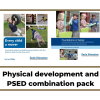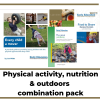Outdoors and Active
Outdoors and Active – an action research project commissioned by the London Borough of Newham – took practitioners from nurseries, schools, PVI settings and children’s
Human beings are “hardwired” to take risks, from birth. Babies take their first independent breaths; they decide to try crawling and walking and then running; they try new foods; they see a tree and want to climb it. Sadly, an increasingly risk averse society is making physically active, playful risk taking ever more difficult for children to practise. Since play is the key way in which young children learn the skills and abilities they need for life, we do them no favours by preventing them from pushing the boundaries of their physicality. Even the Health and Safety Executive says, “The goal is not to eliminate risk, but to weight up the risks and benefits. No child will learn about risk if they are wrapped in cotton wool”. Serious injuries are of course to be avoided, but bumps, bruises, cuts and grazes are an unavoidable, and beneficial, part of childhood, teaching children (through repetition) how to manage their bodies in many different physical situations – in other words, how to react when they do encounter genuine danger.
When you’re out and about with children, aim to enable them to take risks, not prevent them. Risk taking is good for children: taking risks is exhilarating, and children want and need to take risks. Our role as adults is to make sure we enable this, without placing them in actual danger. It’s essential to evaluate the hazards honestly, not just focusing in on the worst-case scenario, but also considering the likelihood of serious injury and what children will gain by participating in the activity. This is called the “risk benefit” approach to play, and in the UK it has been developed and recommended by the Play Safety Forum, the Health and Safety Executive, and even the Department for Education.
So each time children head towards a feature or piece of play equipment, or try an activity that makes you anxious, try the Outdoors and Active Common Sense Top Tips to help them stay as safe as necessary:
Outdoors and Active – an action research project commissioned by the London Borough of Newham – took practitioners from nurseries, schools, PVI settings and children’s
Busy modern lives are having a dramatic impact on the health and wellbeing of our youngest children. They play outdoors less, spend more time being
Little or no equipment is needed to get children active in the park – not even the play equipment that’s probably already there! If there is play
Even everyday journeys and mundane chores can be used to encourage children to be more physically active. Here are some ideas, suggested by the Outdoors
Toddlers need plenty of balance practice once they are up and walking. Each of the three semi-circular canals in the inner ear respond to movement in different
An early task for the Outdoors and Active action researchers was to identify the barriers to taking children out and about beyond the setting. Only
Traditional fixed play equipment is not necessary for physicality; if it’s there, then great – use it. Most of the Outdoors and Active project settings
Children can have fun and be active in any kind of landscape, but there’s no doubt that the more diverse and intriguing the space, the
To audit the current provision for physical development outdoors in your school or setting, you can download our three sample audit sheets below. You should
Are children at your setting moving enough? Do they enjoy plenty of physically active outdoor play? The Newham Outdoors and Active practitioners spent eight months
Some of the childminders involved in the Outdoors and Active project thought that a kit of easy to carry, low cost resources could encourage children
An early task for the Exploring the Wider World project was to identify the barriers to taking children out and about beyond the setting. Only
Risk is a natural part of our existence, as we look to explore and make sense of the world around us. What is key is









Early Education
2 Victoria Square
St Albans
AL1 3TF
T: 01727 884925
E: office@early-education.org.uk